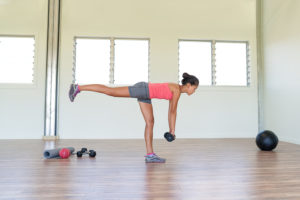3 Exercises to Stronger Glutes
By Chris Kacyon, MS
The glutes are arguably the most important muscles activated in performance events, however with the prevalence of sedentary jobs, our gluteal muscles (gluteus maximus, gluteus medius, gluteus minimus) have been taught to remain inactive for most of the day. When your afternoon workout rolls around and you try and squat or run, the glutes should wake up and do their job, but this is not always the case.

Are Your Glutes Sleepy? A Quick Test
One simple test to measure if you are activating your glutes is to hold a single leg stance with your eyes closed for 60 seconds. This takes visual balancing cues away and forces stabilization to occur within the hips and glutes. If this is challenging, impossible, or you are experiencing any of the symptoms below, you may need to actively strengthen your glutes.
- Knee Pain: A primary function of the glutes is to stabilize the knees in-line with the toes during most movements like squatting and running. Without proper activation of these muscles the knees can collapse inward causing stress, pain and even injury.
- Lower Back Pain: The gluteus maximus is the primary muscle involved when moving your leg backwards. If your glutes are not firing when you are running or squatting, your lower back muscles will be forced to take over and compensate for the extension. Since these muscles are not nearly as strong as the glutes, they tend to become overloaded with the stress.
- Lack of Soreness in Glutes: Lunges, squats and deadlift movements should be initiated by the glute muscles. If your glutes are not sore after these exercises your glutes may not be firing. This does not mean soreness is a prerequisite for performance advancement, but it does give you a clue of which muscles you are activating.
- Tight Hip Flexors: This is more prevalent for those working in a seated environment, where the hip flexors remain in a shortened positon for a prolonged time. This type of individual may have trouble running upright or squatting with an erect spine.
3 Exercises to Strong Glutes
- Isometric Hip Bridge: Lie on the ground with your feet flat and knees bent. Lift your hips off the ground, driving through your heels without hyperextending your lower back. Hold this for 30 seconds and repeat for 2 more sets. Holding a hip bridge prior to a run, squatting, deadlifting will properly activate your glutes.
- Eccentric Single Leg Romanian Deadlift: Stand on one leg with a light dumbbell on the planted side. Push your hips back, lower the dumbbell to the ground while your knees and back are straight. This lowering phase (eccentric) should last for 4 seconds. Repeat this for 15 repetitions on each leg for 3 sets. This movement will help you perfect a proper hip hinge while in an instable environment. With the load pulling you into hip flexion (opposite of the gluteals anatomical function), and slowly lengthening (eccentric) the glutes, a reciprocal forceful contraction of the glutes will occur upon standing. This is due to several neuromuscular mechanisms necessary for tissue preservation.
- Banded Walks: Wrap a small band just above both knees. Starting with a narrow stance, step your right foot forward away from your body at a 45-degree angle followed by your left in the same direction. Now, repeat going towards your left. Repeat for 5 steps forward and then 5 steps backwards as a part of your warm-up. Wrapping a band above the knees while diagonally stepping forward and backwards requires the qlutes to activate while you are moving dynamically.
The importance of proper strength training and movement mechanics cannot be stressed enough. If the glutes are not properly utilized, injury risk increases and performance advances are unlikely.
So there you have it, now go out and wake up your butt!



